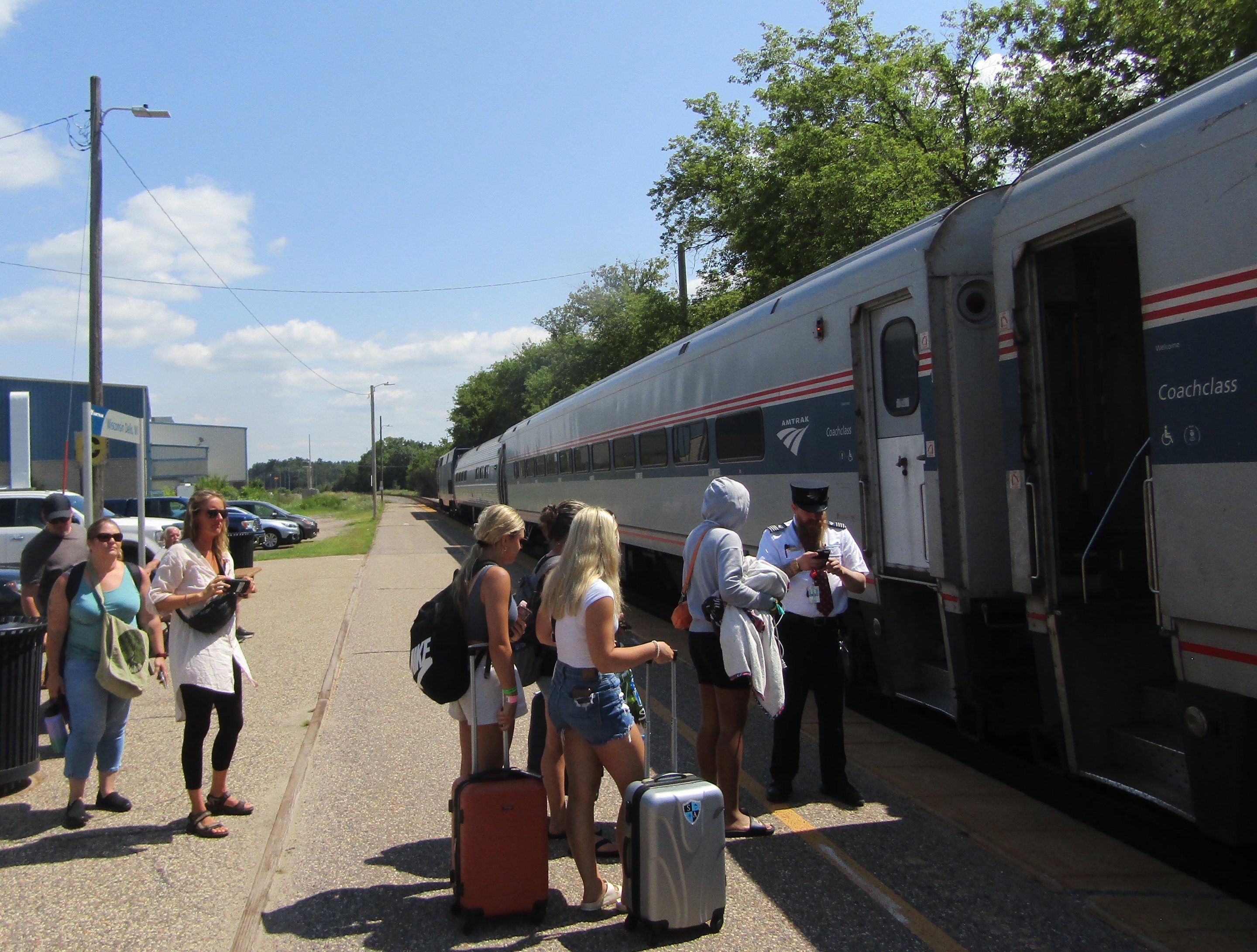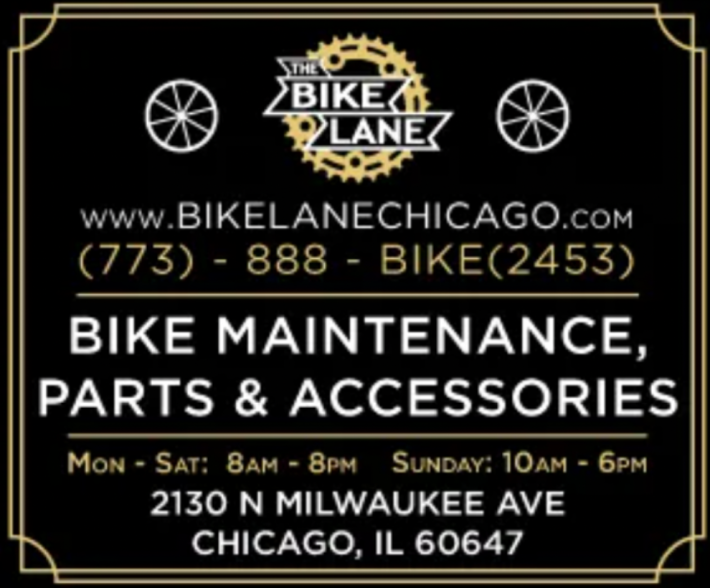
Amtrak’s new Borealis St. Paul/Minneapolis-Milwaukee-Chicago service appears to be off to a strong start, based both on the ridership figures for its first full month of operations, and my own onboard experiences. Launched on May 21, 2024, the route added one more trip a day in each direction between the Twin Cities and the Windy City, at potentially more convenient times than the existing Chicago-Seattle/Portland Empire Builder route. And compared to eastbound Empire Builder runs on this corridor, eastbound Borealis trains are much more likely to be on time.
According to preliminary figures released in early July, the Borealis saw around 18,500 passengers in June, or an average of 300 passengers a day in each direction. The May 2024 Amtrak monthly performance report showed that the service had 6,600 riders during its first 1.5 weeks of operation. The June 2024 report hadn’t been released by press time.
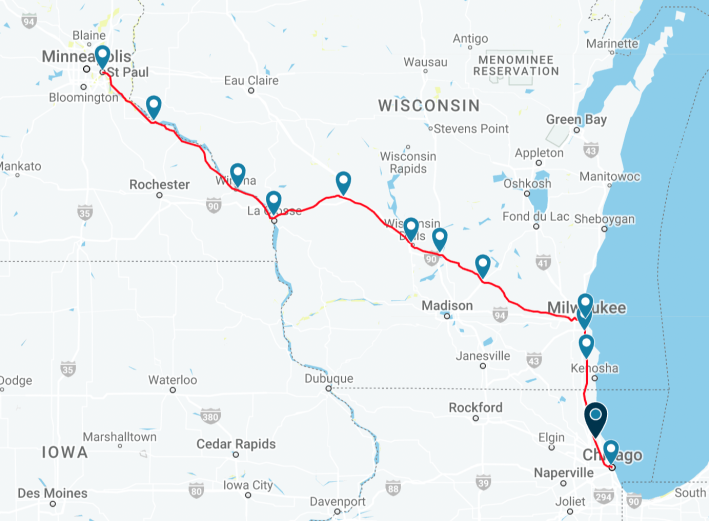
The 2015 Amtrak feasibility report, which paved the way for Borealis service, estimated that between 137,000 and 185,100 riders a year, or an average of 11,417 to 15,425 a month, would use the then-hypothetical route. That means that in May 2024, at least, the Borealis beat that projection by about 20 percent.
On the other hand, Borealis service replaced one Chicago-Milwaukee Hiawatha train in each direction per day. That made me wonder how many Borealis riders were previously riders on those two Hiawatha runs.
We will have to wait for the release of June ridership figures to make an apples-to-apples comparison. But based on what I saw when I took a round trip on the Borealis last Thursday, it’s definitely not just Hiawatha riders.
Riding the Borealis
I took the Borealis to the Wisconsin Dells, a popular tourist destination, for one reason. And, no, it wasn't to participate in local legend Tommy Bartlett's Water Ski & Jumping Boat Thrill Show, in case you were worried about Streetsblog Chicago "jumping the shark." (Sadly, after publication of this piece, we learned that the show permanently closed due to lost revenue during COVID-19.)
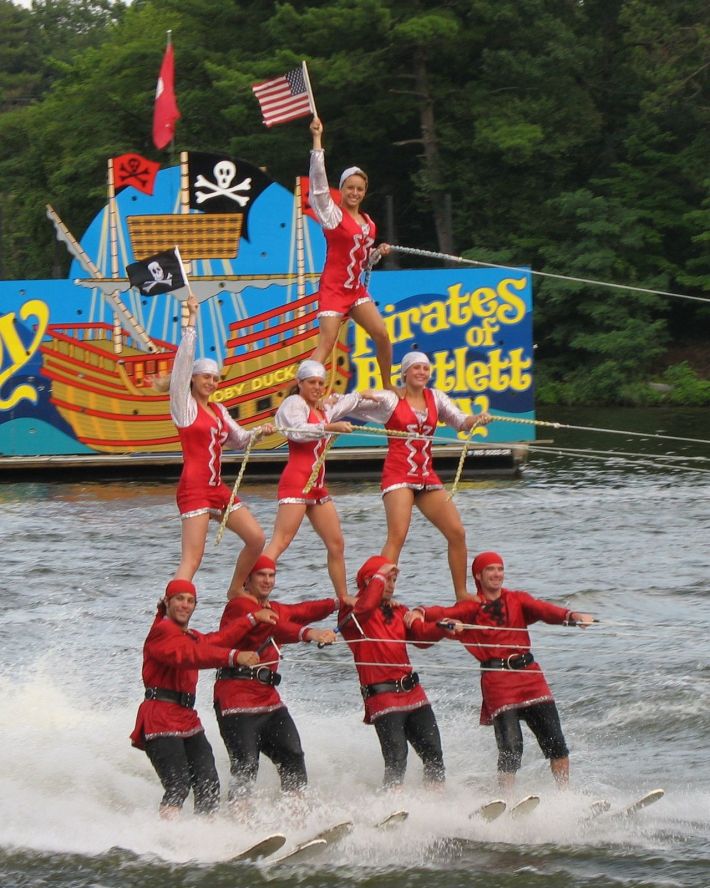
Rather, the Dells stop is the furthest west one can go on the Borealis and still catch the same train service back to Chicago that day.
When I got on the Borealis in suburban Glenview, IL, it was already full enough that there was simply no way to avoid sitting next to another passenger. And there weren’t even that many open seats available, period. "Don’t be afraid to make a friend," a crew member said over the PA system.
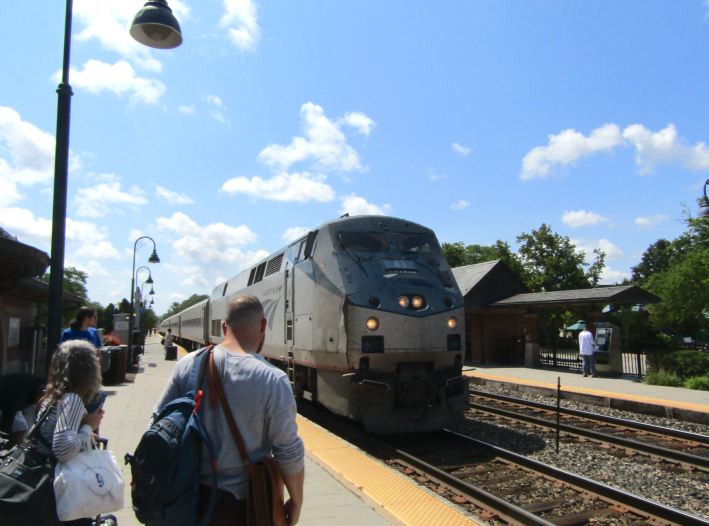
A significant number of riders in the train car I was on disembarked in downtown Milwaukee. But almost as many passengers boarded in Milwaukee to take their places. Over the next three stops – Columbus, Portage, and Wisconsin Dells, WI – the overall number of riders dropped, but only gradually, as new passengers continued to board.
My train home wasn’t as crowded, but what I observed on the way there was still true: There were healthy numbers of passengers boarding and alighting at all the intermediate stops. According to a crew announcement, 90 riders were expected to board in central Milwaukee.
The Borealis uses four Horizon coach cars, which can have anywhere between 68 and 72 seats, plus a cafe/business car that has 19 business-class seats. In other words, those 90 customers who boarded in Milwaukee on my eastbound trip represented roughly 38 percent of the train’s maximum capacity.
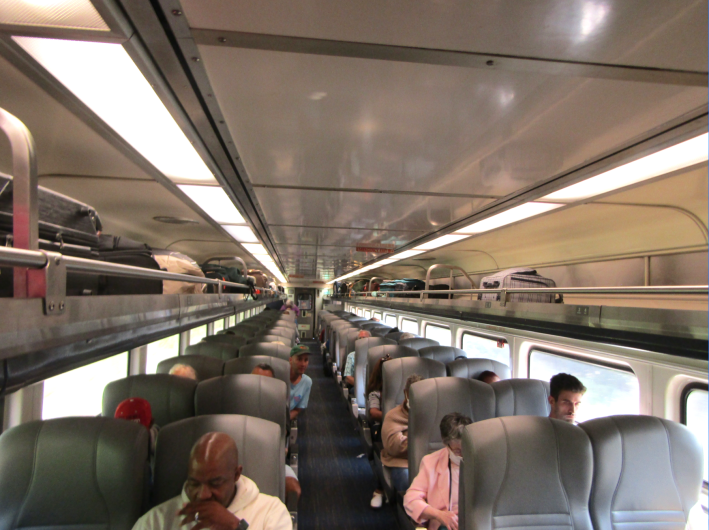
Another rider who boarded in Glenview and disembarked at Portage, said that while he was worried about overcrowding, "I realized that’s a good thing. That means they won’t cancel [the Borealis]."
I’ve taken the Hiawatha to Milwaukee plenty of times to see my sister Anna Bailliekova, who's a member of that city’s Pedestrian and Bicycle Advisory Committee, and her family. The onboard experience on the Borealis and Hiawawatha trains was pretty much the same. You kind of have to roll the dice on the Wi-Fi: Sometimes it’s fairly reliable, and sometimes it’s spotty.
The Horizon passenger cars on the Borealis have comfier seats than the newer Venture cars that have started to appear on the Hiawatha. But I prefer the Venture's power outlets set up (in between seats instead of under windows), better tray tables and, of course, in-car bicycle racks.
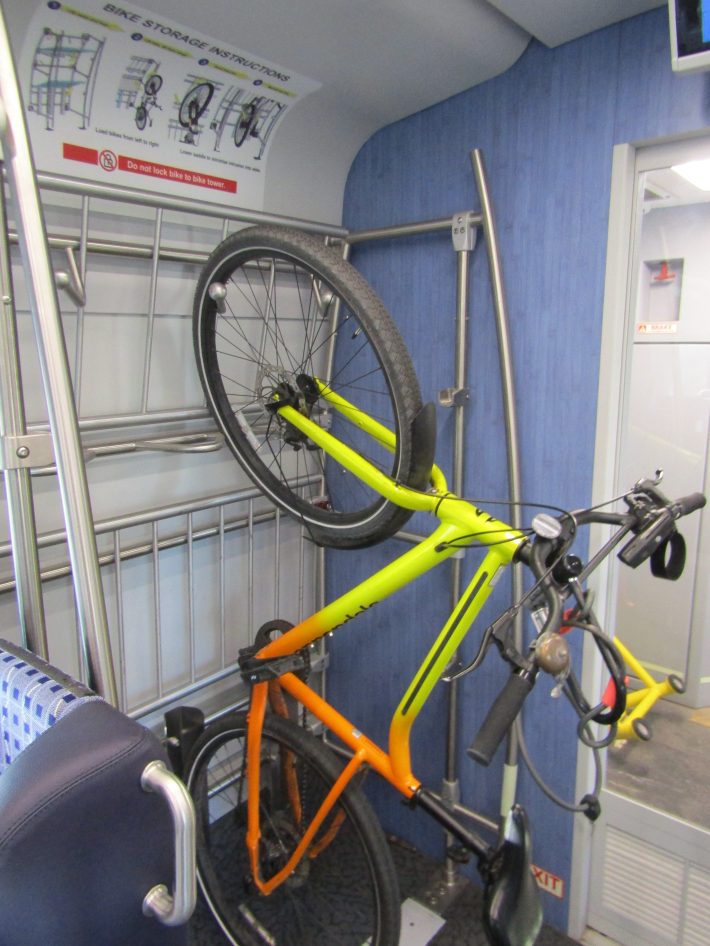
Another thing that makes Borealis runs different from Hiawatha trips is the former have a functioning cafe/business car. (According to my sister Anna, Amtrak does occasionally attach a cafe car to Hiawatha trains, but it doesn’t serve food or drinks.) The cafe car on my trip to the Dells opened about 15 minutes after the train left Glenview, and the crew emphasized that passengers were not supposed to sit around in the cafe car any longer than necessary.
"It is temporary seating only," the cafe car attendant announced. "There’s no outside food or laptops or card games. We will ask you [to leave] if you’re sitting too long and not actively eating or drinking."
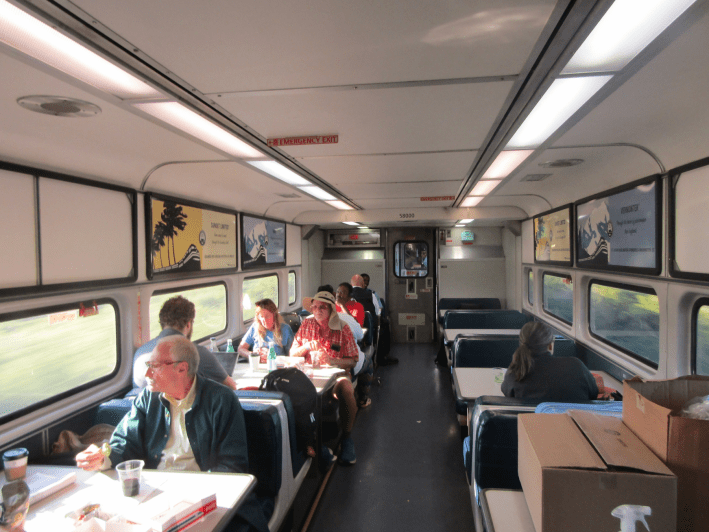
That was understandable, given the crowded train and the fact that cafe/business cars have half of the cafe seating capacity of the cafe cars on long-distance trains. I held off on getting lunch until the train left Milwaukee. By that point, all the talk about kicking people out was forgotten. I saw one passenger napping in full view of crew members filling out paperwork.
In the lead-up to the service launch, Amtrak said that the cafe car would have "regional menu items," but didn't mention any specific items. It turns out that the Borealis cafe menu includes Leinenkugel's (Milwaukee) and Surly (Minneapolis) beer, cold-brew Caribou Coffee (Edina, MN), and a cheese and cracker tray from Kindred Creamery (Muscoda, WI). The Borealis cafe also includes plenty of non-regional items from the regular Midwest Amtrak menu. (Once again, I'll point out they're fools for not offering Twin Cities-style Juicy Lucy burgers. - ED)
Side note: The Horizon coaches have drinking fountains, but post COVID-19, they don't seem to be providing paper cups.
Additional, possibly more convenient, travel times
One thing that's nice about the new Borealis service is that it provides additional, potentially more convenient, scheduled travel times, compared to the Empire Builder.
Every day, the westbound Empire Builder is scheduled to leave Chicago Union Station at 3:05 p.m., arriving at the St. Paul-Minneapolis, MN - Union Depot (located in St. Paul) by 10:56 p.m. The daily eastbound Empire Builder is scheduled to leave St. Paul at 8:50 a.m. and arrive in Chicago by 4:45 p.m.
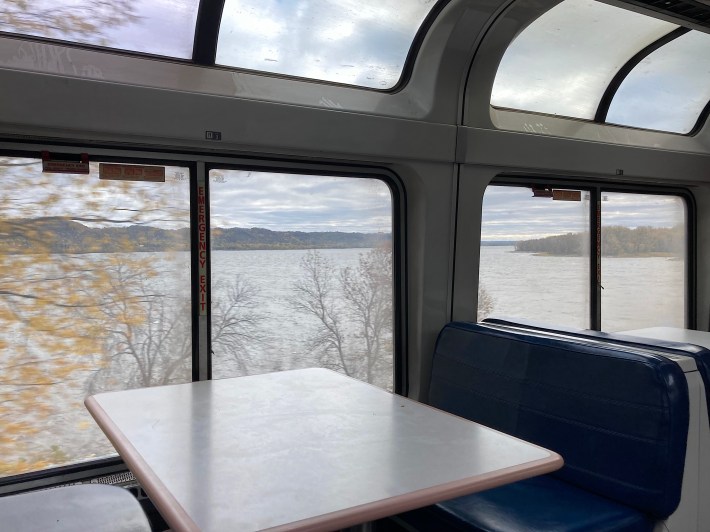
In contrast, every day the westbound Borealis is scheduled to leave Chicago at 11:05 a.m., and arrive in St. Paul by 6:29 p.m. And the eastbound Borealis is supposed to leave the Twin Cities at 11:50 a.m. and arrive in the Windy City at 7:14 p.m.
So, for example, the Borealis might be a more convenient choice for Chicagoans who want to spend a three-day weekend visiting the Twins. You'd leave late Friday morning, and arrive in time for dinner and a show, rather than at almost 11 p.m.

And you wouldn't have to get up early on Sunday to catch the 8:50 a.m. Empire Builder home. (If you have good luck – more on that in a second.) Instead you could enjoy a leisurely morning before boarding the 11:50 a.m. Borealis back to Chicago.
Eastbound Borealis runs are more likely to be on time than eastbound Empire Builders
Here's another big perk of Borealis service.
Any delays on westbound Empire Builder trains heading from Chicago to the Twin Cities tend to be relatively short. But eastbound Empire Builders runs often get delayed when they encounter freight train traffic in oil-rich Montana and North Dakota. It’s not unusual for those eastbound Empire Builders to arrive in St. Paul hours late.
My westbound Borealis train arrived at Wisconsin Dells at 2:37 p.m., only four minutes late – practically a margin of error by Amtrak standards. But when I went inside the station, I saw that there were still passengers waiting for the Chicago-bound Empire Builder, which was scheduled to arrive at 12:58 p.m., so their train was running almost an hour and forty minutes late.
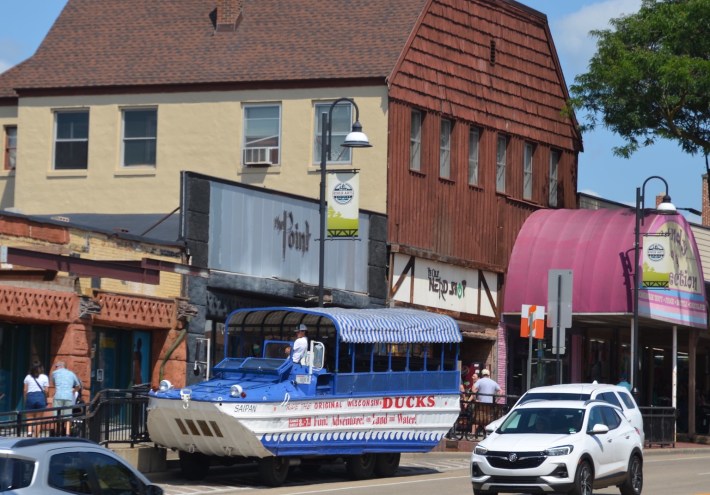
I only had an hours to kill in the Dells. I spent that checking out the sights, buying a local newspaper, and stopping in at the library.
On my way home, my eastbound Borealis left right on schedule, at 3:40 p.m. As I was pulling up my ticket, I noticed a family that had been waiting for the eastbound Empire Builder when I arrived, so their run was around two hours and forty minutes late. "[The Empire Builder] is half an hour away,” the conductor told the mother apologetically. The family ultimately was able to board the on-time eastbound Borealis instead.
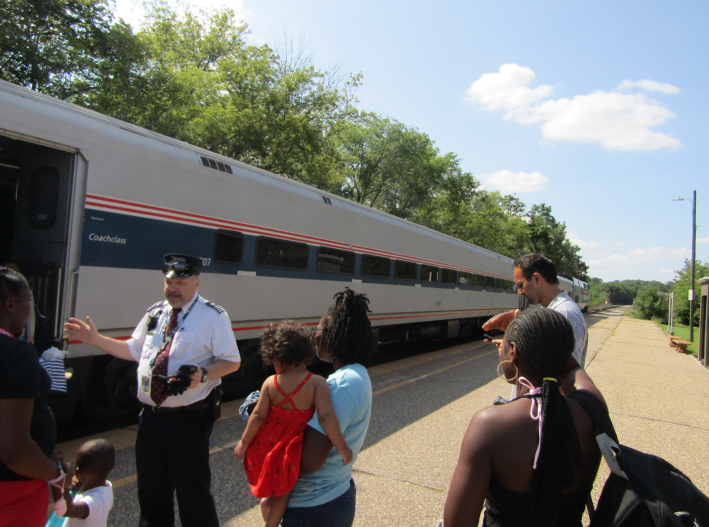
As our Borealis headed east, I kept seeing people sitting at stations, still waiting for the Chicago-bound Empire Builder to arrive. When I checked Amtrak's Track A Train website around Portage, WI, it showed that the eastbound Empire Builder was a staggering three hours and 36 minutes late. In contrast, my Borealis ended up arriving in Glenview 10 minutes late, which is not ideal, but isn't egregious.
The moral of the story is, if you want to greatly improve the chances that your train from the Twin Cities or points east to Chicago won't be ridiculously late, book an eastbound Borealis ticket instead of an eastbound Empire Builder trip.
The future
In a July news release, Ray Lang, Amtrak's vice president for Amtrak state-supported services, stated that the railroad expects Borealis’ ridership to keep increasing. "Amtrak and our state partners have always believed the Twin Cities-Milwaukee-Chicago corridor was a great one with tremendous opportunity," he said. "The ridership numbers we have seen so far confirm our belief and we expect this trend to continue as the service matures and we head into the peak summer travel season. With strong college and university markets on this route, we are confident Borealis will continue to perform well when students and staff travel in greater numbers this fall."
Word is, thanks to the Borealis ridership success, Amtrak is considering adding another daily run. The service is currently funded by a federal grant, but once that runs out, the Illinois, Wisconsin and Minnesota departments of transportation will be responsible for the majority of the funding.
Amtrak spokesperson Marc Magliari told Streetsblog that, while there has been interest, so far there have been no "substantive discussions" about increasing Borealis service.
So will the state DOTs chip in on additional convenient and relatively prompt new Borealis runs between Chicago and the Twin Cities anytime soon? In the words of Minneapolis rock band The Replacements, we "Can't Hardly Wait".
After this article came out Magliari told Streetsblog, "The federal grant supporting the start-up has a muti-year step down to 'run out.' It sounds like Igor is hoping it won’t take eight years before we add more service."
Check out more photos from Igor Studenkov's Borealis trip to Wisconsin Dells and back here.

Did you appreciate this post? Please consider making a tax-deductible donation, to help keep Streetsblog Chicago's sustainable transportation news and advocacy articles paywall-free.
